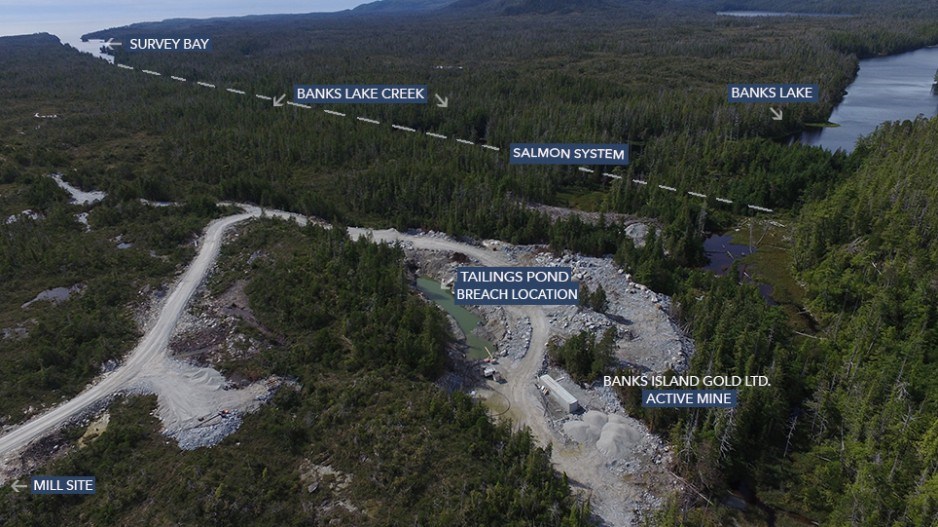The Gitxaala First Nation are launching a judicial review of seven mineral claims in their territory, on Banks Island, and more broadly challenging the Mines Act and Mineral Tenure Act, which they say breaches conventions and legal requirements, including the duty to consult.
The Gitxaala, backed by West Coast Environmental Law, have launched a judicial review in the BC Supreme Court, asking the court to overturn seven mineral claims granted for exploration on Banks Island, a large, mostly uninhabited Island in Gitxaala traditional territory.
Between 2018 and 2020, the province granted seven mineral claims on Banks Island without consulting the Gitxaala, the First Nation says in a legal backgrounder.
"These mineral claims occurred without consent, consultation or even notification to Gitxalla," said Gitxaala chief councillor Linda Innes.
"For too long, anyone with a computer and $34 has been able to acquire rights to minerals on the traditional territory of Gitxaala Nation.
"It's a complete disregard of our own laws and governance, and in violation of both the government's constitutional requirements and the United (Nations) Declaration on the Rights of Indigenous Peoples (UNDRIP), which B.C. committed to implement."
About 16% of Banks Island is under a mineral claim, Innes said, and one of those claims eventually was developed into a small gold mine that resulted in an environmental mess. In 2015, the Banks Island Gold company's Yellow Giant gold mine on Banks Island (also known as the Tel mine) was shut down by the provincial government for unauthorized discharges of effluent. The company went bankrupt, and left behind an environmental liability.
As BIV News reported in 2015, the mine was just small enough not to trigger an environmental review under the BC Environmental Assessment Act, which meant it was not subjected to the scrutiny, oversight or duty to consult First Nations that a larger mine would have been.
The mine had no tailings pond. Tailings were simply dumped into a "glory hole" -- a depression created when the workings from an old underground mine break through the surface. Heavy rain and a failed sump pump resulted in flooding that spilled water and tailings effluent into local waterways The mine continues to pollute local fish-bearing streams, Innes said.
"The Gitxaala has been living with the consequences of bad mining for years," Innes said.
She added that the legal challenge is not about the Yellow Giant mine (also known as the Tel mine), but rather is intended to prevent any further such developments occurring without Gitxaala consent or knowledge.
"We have repeatedly called for an end to mining activities on Banks Island," Innes said. "This includes the granting of mineral rights on which these practices are founded upon."
The John Horgan government enshrined UNDRIP into B.C. law through the Declaration on the Rights of Indigenous Peoples Act (DRIPA). The Gitxaala will argue that granting mineral claims without the consent -- or even knowledge -- of the Gitxaala in their traditional territory is a violation of that act. They will also ask the court to order an amendment of the Mineral Tenure Act to bring it into compliance with DRIPA.
"Gitxaala asks the court to declare that DRIPA legally requires the B.C. government to consult and cooperate with Gitxaala (as well as other indigenous peoples) about measures necessary to bring the Mineral Tenure Act regime into consistency with UNDRIP," the legal backgrounder states.
Kendra Johnston, president of the Association for Mineral Exploration (AME), said filing a mineral claim is just the first step in mineral exploration, and that the process does involve consultation with First Nations, before actual exploration activity takes place.
“Staking a mineral claim is only one step in an extensive permitting process," she said in a statement to BIV News. "Mineral explorers in British Columbia are regulated by some of the highest standards in the world. Before any work begins, mineral exploration companies must first complete a detailed Notice of Work application process, which includes government to government consultation with Indigenous groups who may benefit or be impacted by the exploration work."
The Ministry of Energy, Mines and Low Carbon Innovation said it does not respond to matters before the court, but said it already has been in consultation with First Nations on reforming the Mineral Tenure Act.
"In 2018 and 2019, the Ministry of Energy, Mines and Low Carbon Innovation, First Nations, Indigenous organizations, and mining industry associations engaged in initial discussions on the Mineral Tenure Act (MTA) and potential reforms to the mineral tenure system," the ministry said in a statement to BIV News. "Conversations identified direct linkages between the mineral tenure system and modernized land use planning and the need for additional engagement."
Editor's note: This story has been updated with reactions from the AME and Ministry of Energy and Mines.




